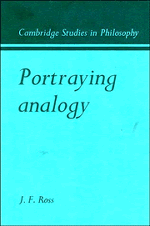Book contents
- Frontmatter
- Contents
- Dedication
- Preface
- Introduction
- 1 The limitations of classical analogy theory and the Miller's Analogies transition
- 2 The genus: meaning differentiation
- 3 Predicate schemes: an explanatory model
- 4 Equivocation, analogy and metaphor
- 5 Denominative analogy and paronymy
- 6 Figurative discourse
- 7 Analogy and religious discourse: craftbound discourse
- 8 Analogy and analysis
- Notes
- Bibliography
- Name index
- Subject index
3 - Predicate schemes: an explanatory model
Published online by Cambridge University Press: 07 October 2011
- Frontmatter
- Contents
- Dedication
- Preface
- Introduction
- 1 The limitations of classical analogy theory and the Miller's Analogies transition
- 2 The genus: meaning differentiation
- 3 Predicate schemes: an explanatory model
- 4 Equivocation, analogy and metaphor
- 5 Denominative analogy and paronymy
- 6 Figurative discourse
- 7 Analogy and religious discourse: craftbound discourse
- 8 Analogy and analysis
- Notes
- Bibliography
- Name index
- Subject index
Summary
Predicate schemes are the meaning-relevant portions of paradigmatic sets
PARADIGMATIC SETS: CO-APPLICABLE WORDS
Contrast and meaning To have meaning, an expression must be in contrast of meaning; it must have differential meaning – function contrastively to something else (Lyons 1966: 422; 1963: 59). Equivocal words stand in diverse contrast patterns with other words: for example, they may not have the same opposites (sharp:dull;sharp:flat). That provides the purchase for modelling the meaning relationships under inquiry.
As Lyons described combinatorial contrasts, there are two basic kinds: syntagmatic and paradigmatic (1966: 70ff, 117, 428f, 460; 1977 vol.1: 48, 55). An expression paradigmatically contrasts with all other expressions that could have been inserted in its place (the remainder of the sentence remaining substantially unchanged) to produce replacement sentences that are semantically acceptable within the given environment and preserve the consistency (or inconsistency) of the original. A native speaker must not find the substituted result so incongruous that his critical reply would be the equivalent of ‘That's not English; one doesn't say that’.
The set of words in paradigmatic contrast with a given word may be imagined as a vertical list of words substitutable (under the conditions mentioned) for the same place, or role, in a given sentence frame, e.g. ‘The youth/young man/boy/urchin/girl/matron/etc. asked for a job.’ It is the list of co-applicable words (see definitions below).
Syntagmatic contrasts are the differing semantic and syntactic limitations expressions impose linearly upon what can be combined with them into an acceptable sentence.
- Type
- Chapter
- Information
- Portraying Analogy , pp. 54 - 85Publisher: Cambridge University PressPrint publication year: 1982

